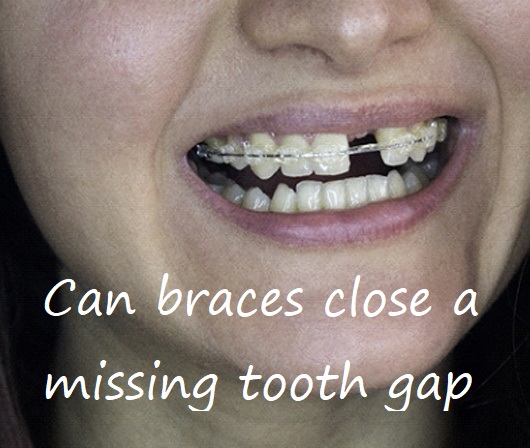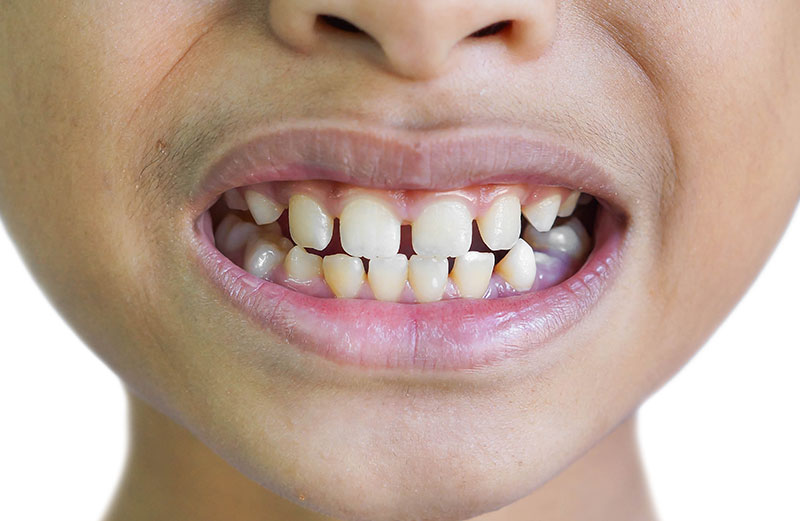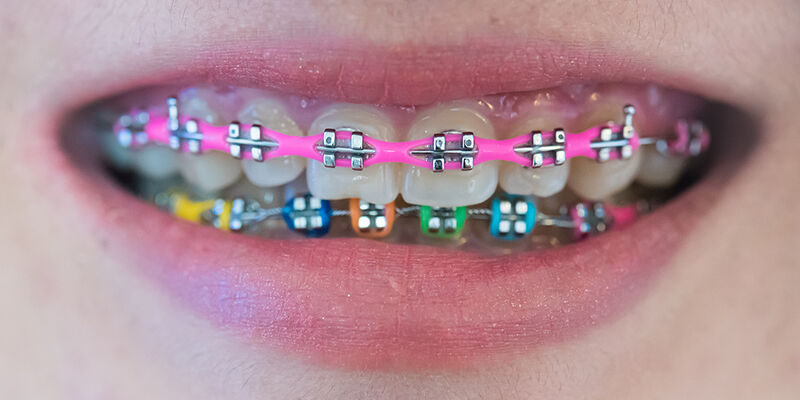Can braces close a missing tooth gap

When people hear the word “braces,” they often think of a solution to crooked teeth, overbites, or underbites. However, braces can also address gaps in teeth, including those caused by missing teeth. This article explores how braces can close a missing tooth gap, the processes involved, alternative treatments, and what to expect during the treatment.
Understanding Tooth Gaps
Tooth gaps, also known as diastemas, can occur naturally or due to missing teeth. They can result from several factors, including genetics, the size of the jaw, habits like thumb sucking, and dental issues such as periodontal disease. Missing teeth create a more significant challenge because the gap is larger and involves more complex dental structures.
How Braces Work
Braces work by applying continuous pressure over time to move teeth into the desired position. This movement occurs as the bones in the jaw adapt to accommodate the new positions of the teeth. The main components of braces include:
- Brackets: Small squares bonded directly to the front of each tooth.
- Archwires: Thin metal wires that connect the brackets and guide the movement of teeth.
- Bands: Metal rings placed around the molars to anchor the brackets.
- Ligatures: Tiny rubber bands or metal ties that hold the archwires to the brackets.
Can Braces Close a Missing Tooth Gap?
Yes, braces can close a gap caused by a missing tooth, but it depends on several factors, including the size of the gap, the condition of the surrounding teeth, and the overall dental health of the patient.
Factors to Consider
- Size of the Gap: Smaller gaps can be closed more easily with braces. Larger gaps may require additional dental treatments.
- Health of Surrounding Teeth: The teeth adjacent to the gap must be healthy and strong enough to support the movement required.
- Overall Dental Health: Good oral hygiene is crucial for the success of orthodontic treatments. Issues like gum disease must be addressed before starting the treatment.
The Process of Closing a Missing Tooth Gap with Braces
- Consultation and Examination: The first step is a thorough examination by an orthodontist. This includes X-rays, photographs, and dental impressions to create a detailed treatment plan.
- Placement of Braces: Braces are applied to the teeth. The orthodontist will explain how to care for them and what to expect in the coming months.
- Regular Adjustments: Periodic visits to the orthodontist are necessary to adjust the braces. These adjustments ensure the teeth are moving as planned.
- Monitoring Progress: The orthodontist will monitor progress and make any necessary adjustments to the treatment plan.
- Retention Phase: After the gap is closed, a retainer is used to maintain the new position of the teeth.
Alternatives to Braces for Closing a Missing Tooth Gap
While braces are a common solution, other treatments might be more suitable depending on the individual case:
- Dental Implants: A dental implant is a surgical procedure where an artificial tooth root is placed into the jawbone, and a replacement tooth is attached. This is a permanent solution that looks and functions like a natural tooth.
- Dental Bridges: A bridge consists of a false tooth (or teeth) held in place by crowns on the adjacent teeth. This can effectively close the gap and restore the smile.
- Partial Dentures: Removable dentures can replace one or more missing teeth and are a less invasive option compared to implants and bridges.
Pros and Cons of Using Braces to Close a Missing Tooth Gap
Pros
- Non-Invasive: Unlike implants, braces are non-invasive and do not require surgery.
- Comprehensive Treatment: Braces can address other alignment issues simultaneously, providing a more comprehensive solution.
- Customizable: Treatment plans are tailored to each individual’s needs.
Cons
- Time-Consuming: Orthodontic treatments can take several months to years to complete.
- Maintenance: Braces require diligent oral hygiene and regular visits to the orthodontist.
- Discomfort: Adjustments can cause temporary discomfort and soreness.
Case Studies and Success Stories
Many individuals have successfully closed gaps caused by missing teeth using braces. For instance:
- Case Study 1: A 25-year-old patient with a missing upper lateral incisor used braces and a temporary prosthetic tooth. After 18 months, the gap was closed, and the patient had a harmonious smile.
- Case Study 2: A teenager with a congenital missing tooth and adjacent spacing issues used braces to close the gap and align the remaining teeth. The treatment took two years but resulted in a perfect smile.
Preparing for Orthodontic Treatment
Initial Consultation
Before starting treatment, an initial consultation with an orthodontist is essential. This appointment will include a comprehensive examination of your teeth, gums, and jaw. The orthodontist will discuss your goals, explain the treatment options, and develop a customized plan tailored to your needs.
Diagnostic Records
The orthodontist will take various diagnostic records, including X-rays, photographs, and dental impressions. These records help in creating an accurate treatment plan and tracking progress throughout the treatment.
The Journey with Braces
Getting Braces
The process of getting braces involves several steps:
- Cleaning and Drying: Your teeth will be thoroughly cleaned and dried to ensure proper adhesion of the brackets.
- Application of Brackets: The orthodontist will apply a special adhesive to attach the brackets to your teeth.
- Placement of Archwires: The archwires are threaded through the brackets and secured with ligatures.
- Final Adjustments: The orthodontist will make any final adjustments to ensure the braces are comfortable and functioning correctly.
Life with Braces
Adjusting to life with braces can take some time. Here are some tips to help you manage:
- Oral Hygiene: Brushing and flossing become even more critical with braces. Use a soft-bristled toothbrush and orthodontic flossers to clean around the brackets and wires.
- Dietary Changes: Avoid hard, sticky, and chewy foods that can damage the braces. Opt for soft foods and cut your food into smaller pieces.
- Managing Discomfort: It’s common to experience some discomfort after adjustments. Over-the-counter pain relievers and orthodontic wax can help alleviate soreness and irritation.
Regular Orthodontic Visits
You’ll need to visit the orthodontist regularly for adjustments and progress checks. During these visits, the orthodontist will:
- Adjust the Archwires: Tighten or replace the archwires to ensure continuous movement of the teeth.
- Check for Progress: Monitor the movement of your teeth and make any necessary changes to the treatment plan.
- Address Issues: Fix any broken brackets or wires and address any concerns you may have.
Retention Phase
Once the treatment with braces is complete, the retention phase begins. Retainers are crucial in maintaining the new position of your teeth and preventing them from shifting back. There are different types of retainers:
- Fixed Retainers: A thin wire bonded to the back of the teeth, providing permanent retention.
- Removable Retainers: Clear plastic trays or traditional wire retainers that can be taken out for cleaning and eating.
Post-Treatment Care
After your braces are removed, maintaining good oral hygiene and regular dental check-ups is essential. Your orthodontist will provide instructions on how to care for your retainers and ensure your teeth remain in their new positions.
Long-Term Benefits of Closing a Missing Tooth Gap with Braces
Correcting gaps in teeth, especially those caused by missing teeth, can have several long-term benefits:
- Improved Oral Health: Properly aligned teeth are easier to clean, reducing the risk of tooth decay and gum disease.
- Enhanced Aesthetics: Closing gaps can significantly improve the appearance of your smile, boosting your confidence and self-esteem.
- Better Functionality: Correcting alignment issues can improve your bite and make it easier to chew and speak.
- Preventing Further Dental Issues: Misaligned teeth can lead to additional dental problems, such as wear and tear on teeth, jaw pain, and even headaches. Addressing these issues early can prevent more serious complications.
The Psychological Impact of Closing a Missing Tooth Gap
A gap in your teeth, especially if it is noticeable, can have a significant impact on your self-esteem and confidence. Many people feel self-conscious about smiling or speaking in public if they have a visible gap. By closing the gap, braces can help restore your confidence and improve your overall quality of life.
Frequently Asked Questions
1. How long does it take to close a gap with braces?
The time required to close a gap with braces varies depending on the size of the gap, the condition of the surrounding teeth, and the individual treatment plan. On average, it can take anywhere from six months to two years.
2. Are there any risks associated with using braces to close a missing tooth gap?
As with any orthodontic treatment, there are some risks, including tooth decay, gum disease, and root resorption. However, these risks can be minimized with proper oral hygiene and regular orthodontic visits.
3. Can adults use braces to close a missing tooth gap?
Yes, braces are effective for adults as well as children. Many adults choose braces to address gaps and other alignment issues, achieving excellent results.
4. Will closing a gap with braces affect my bite?
Orthodontists take great care to ensure that closing a gap does not negatively affect your bite. In fact, properly aligned teeth can improve your bite and overall oral health.
5. Are there any alternatives to braces for closing a gap?
Yes, alternatives include dental implants, bridges, and partial dentures. Your orthodontist or dentist can help you determine the best option based on your specific needs and dental health.
The Importance of Choosing the Right Orthodontist
Selecting an experienced and qualified orthodontist is crucial for the success of your treatment. Here are some tips to help you choose the right orthodontist:
- Credentials and Experience: Ensure the orthodontist is board-certified and has experience in treating cases similar to yours.
- Reviews and Testimonials: Read reviews and testimonials from previous patients to gauge their satisfaction with the treatment.
- Consultation: Schedule a consultation to discuss your treatment options and ask any questions you may have.
- Technology and Techniques: Inquire about the technology and techniques used in the practice to ensure you receive the most up-to-date care.
The Role of Technology in Orthodontic Treatment
Advancements in orthodontic technology have made treatments more effective and comfortable. Some of these advancements include:
- Digital Impressions: Digital impressions replace traditional molds, providing more accurate measurements and a more comfortable experience.
- 3D Imaging: 3D imaging allows orthodontists to create detailed treatment plans and monitor progress more effectively.
- Self-Ligating Braces: These braces use a special clip instead of elastic bands, reducing friction and often shortening treatment time.
- Clear Aligners: Clear aligners, like Invisalign, are an alternative to traditional braces and can be used to close gaps. They are virtually invisible and can be removed for eating and cleaning.
Maintaining Oral Hygiene with Braces
Maintaining good oral hygiene is crucial during orthodontic treatment. Here are some tips to keep your teeth and gums healthy:
- Brushing: Brush your teeth at least twice a day using a soft-bristled toothbrush. Pay special attention to cleaning around the brackets and wires.
- Flossing: Use orthodontic flossers or a water flosser to clean between your teeth and under the wires.
- Mouthwash: Use an antibacterial mouthwash to help reduce plaque and prevent gum disease.
- Regular Dental Check-Ups: Continue to visit your dentist for regular check-ups and cleanings.
Dietary Considerations with Braces
Certain foods can damage braces or make cleaning more difficult. Here are some dietary tips to follow during your treatment:
- Avoid Hard Foods: Foods like nuts, hard candies, and ice can break brackets and wires.
- Skip Sticky Foods: Sticky foods like gum, caramel, and toffee can get stuck in your braces and are difficult to clean.
- Cut Food into Smaller Pieces: Cutting food into smaller, manageable pieces makes it easier to chew and reduces the risk of damaging your braces.
- Opt for Soft Foods: Soft foods like yogurt, mashed potatoes, and bananas are gentle on your braces and easier to eat.
The Cost of Orthodontic Treatment
The cost of braces and other orthodontic treatments can vary widely depending on several factors, including the complexity of the case, the type of braces used, and the location of the practice. Here are some tips for managing the cost:
- Insurance: Check if your dental insurance covers orthodontic treatments and what portion they will cover.
- Payment Plans: Many orthodontists offer payment plans to help spread the cost over time.
- Health Savings Accounts (HSAs) and Flexible Spending Accounts (FSAs): These accounts can be used to pay for orthodontic treatment with pre-tax dollars.
Conclusion
Braces are a versatile and effective solution for closing gaps caused by missing teeth. While the process requires time, patience, and commitment, the results can be life-changing, providing a beautiful and functional smile. By working closely with your orthodontist and following their guidance, you can achieve the best possible outcome for your dental health and aesthetics.
Final Thoughts
Addressing a missing tooth gap with braces is a viable and effective solution for many individuals. By understanding the process, benefits, and considerations, you can make an informed decision and achieve the smile you’ve always wanted. Remember, every smile is unique, and working with a skilled orthodontist can help you find the best path to a confident, beautiful smile.
FAQs Revisited
1. How long does it take to close a gap with braces?
The time required to close a gap with braces varies depending on the size of the gap, the condition of the surrounding teeth, and the individual treatment plan. On average, it can take anywhere from six months to two years.
2. Are there any risks associated with using braces to close a missing tooth gap?
As with any orthodontic treatment, there are some risks, including tooth decay, gum disease, and root resorption. However, these risks can be minimized with proper oral hygiene and regular orthodontic visits.
3. Can adults use braces to close a missing tooth gap?
Yes, braces are effective for adults as well as children. Many adults choose braces to address gaps and other alignment issues, achieving excellent results.
4. Will closing a gap with braces affect my bite?
Orthodontists take great care to ensure that closing a gap does not negatively affect your bite. In fact, properly aligned teeth can improve your bite and overall oral health.
5. Are there any alternatives to braces for closing a gap?
Yes, alternatives include dental implants, bridges, and partial dentures. Your orthodontist or dentist can help you determine the best option based on your specific needs and dental health.
By understanding all aspects of using braces to close a missing tooth gap, you can approach your treatment with confidence and clarity, knowing that you’re making the best decision for your oral health and overall well-being.
Related to read:
Best Oral Hygiene Practices For Optimum Oral Health.
How to Whiten Teeth Naturally?
How to keep your gums healthy and disease-free?
References
To ensure the information provided is accurate and up-to-date, the following sources were referenced:
- American Dental Association. (n.d.). Plaque and Tartar. Retrieved from ADA website
- Mayo Clinic. (n.d.). Dental Plaque. Retrieved from Mayo Clinic website
- National Institute of Dental and Craniofacial Research. (n.d.). Periodontal (Gum) Disease. Retrieved from NIDCR website








